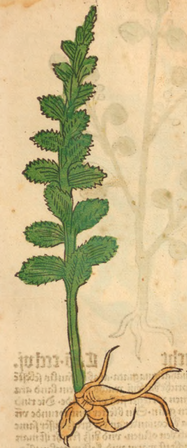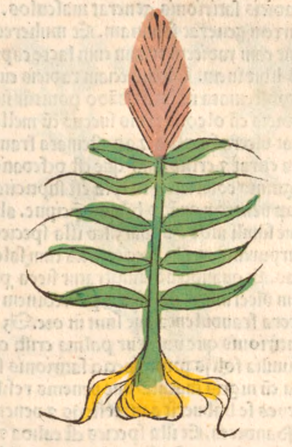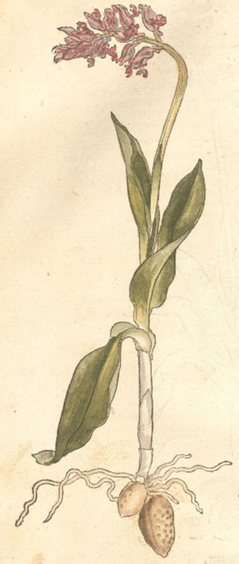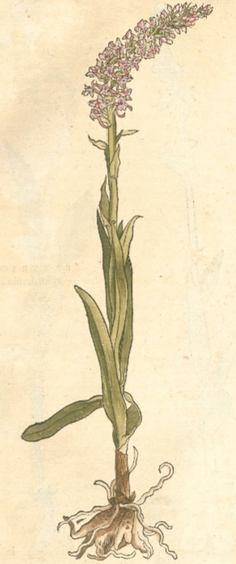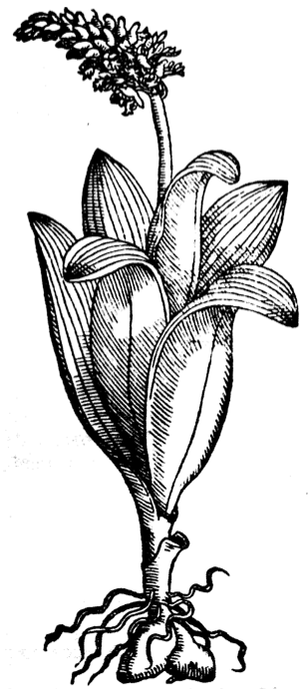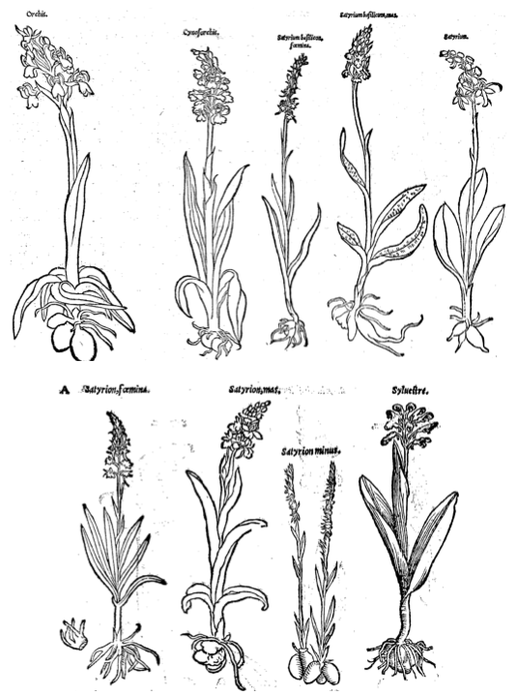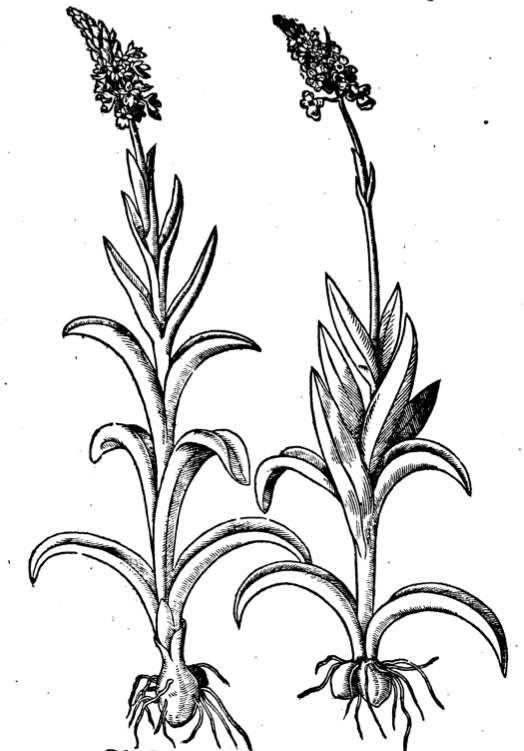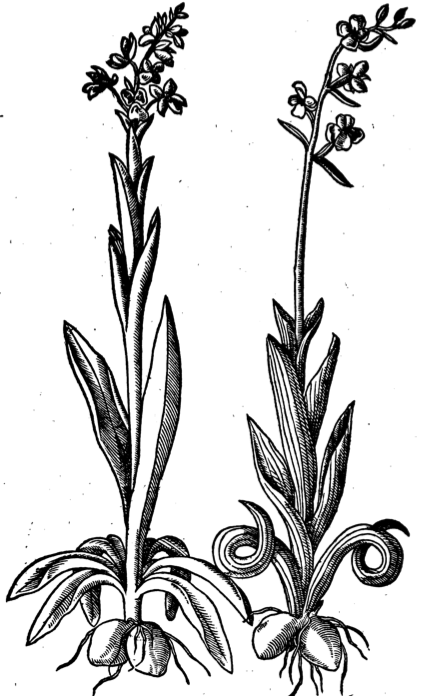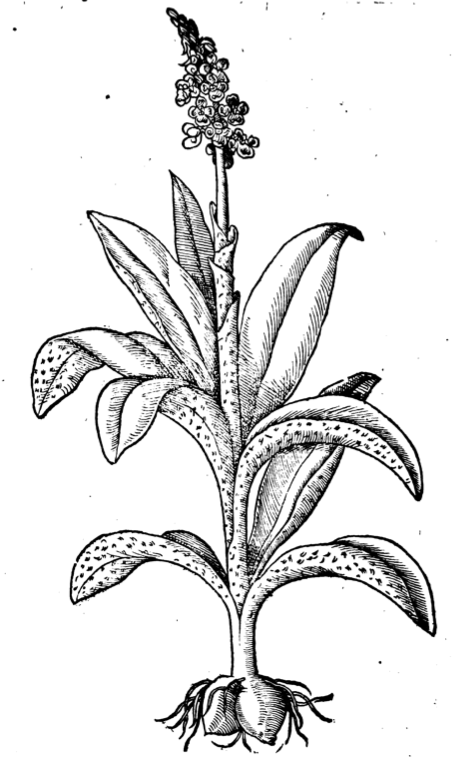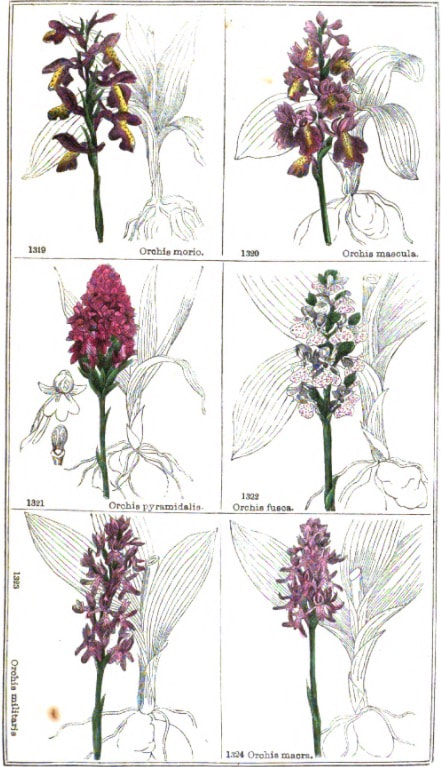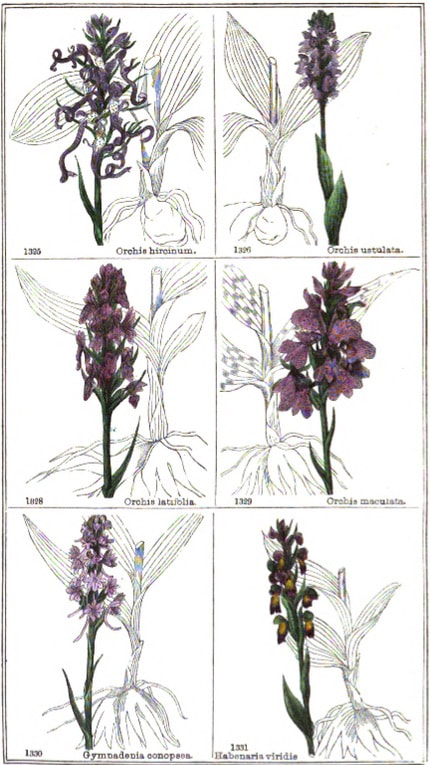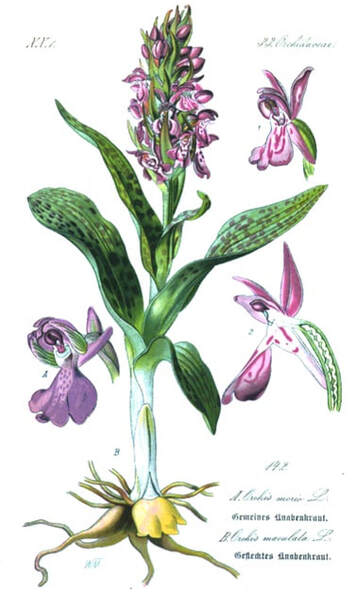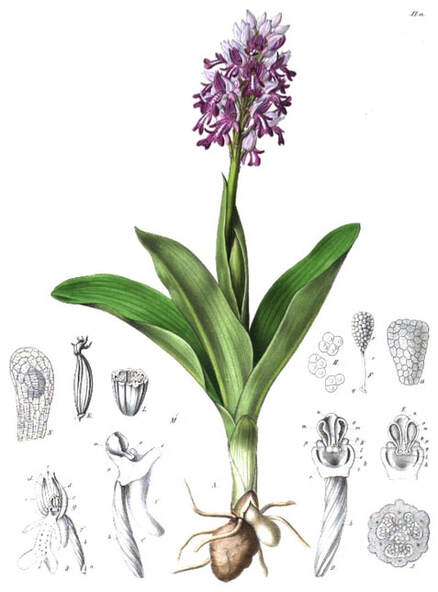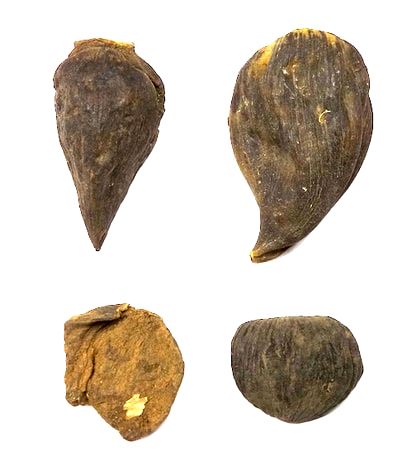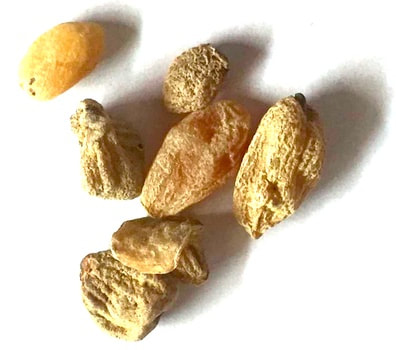Sentry Page Protection
Orchis, Satyrion
Testiculus; Dog Stones
Salab Misri (Ayurveda)
Salep, Salab (Unani)
Dbang po lag pa དབང་པོ་ལག་པ (Tibetan)
Salab Misri (Ayurveda)
Salep, Salab (Unani)
Dbang po lag pa དབང་པོ་ལག་པ (Tibetan)
|
Della Materia Medicinale
Andrea Valuassori, 1562 |
Several different species from
Dioscorides Materia Medica, Ruellio, 1549 |
Varieties of Orchis
New Kreuterbuch, Matthiolus, 1563
New Kreuterbuch, Matthiolus, 1563
A number of Orchis and Gymnadenia species used for Satyrion
Florigraphia Britannica, Deakin, 1857
Florigraphia Britannica, Deakin, 1857
|
Salab Gatta
Orchis latifolia (Calcutta Unani College, Adam, 2019) |
Orchid 'Salab Misri' as used
by the Muslim Uyghur minority in XinJiang, China (Photo, Adam 2017) |
Botanical name:
Orchis spp.
Ovoid and Palmate Tubers are differentiated:
Two main varieties on the Market today:
Other Species supplying Salep:
1. Dactylorhiza, Finger root (This was sometimes listed as 'Female' Orchid or Salep); Dactylorhiza sambucina is most commonly collected as "Salep" in Greece.
2. Habenaria bifolia
3. Ophrys apifera or Aceras anthropophora
4. In Northern India, the more cylindrical tubers of Eulophia campestris and E. herbacea are used as a substitute, sold under the name Salabmisri. These are darker in color, 25-35mm long, 3-8mm broad, and forked at the base.
5. Gymnadenia conopsea was collected and used synonymously with European Orchis species.
6. In Australia, Microtis media has been used.
7. In Afghanistan, the larger corms of Allium macleani has been used under the name Badshah or 'Royal Salep'.
Parts used:
Root (Tuber)
"Satyrion resembles the fox testes and is of two kinds; one being smaller than the other. Two pairs are found; one of them is held slightly higher and is soft while the other is lower in position and is thick. The other kind is bigger in size". (Avicenna)
Temperature & Taste:
Warm, moist. Sweet.
Classifications:
3I. APHRODISIAC. 3J. INCREASE SEMEN
4i. UTERINE. 4j. NERVINE
Orchis spp.
- O. maculata (Spotted Orchid, syn. Dactyloriiza masculata)
- O. mascula (Purple Orchid)
- O. latifolia
- O. Morio
- O. militaris
- O. pyramiadalis and others.
Ovoid and Palmate Tubers are differentiated:
- Ovoid tubers are primarily gathered from O. mascula (Purple Orchid), O. morio, O. pyramiadalis; less frequently O. militaris, O. fusca, O. coriophora. Related plants that have also furnished Ovoid tubers of trade include Ophrys apifera and Aceras anthropophora. Ovoid tubers are generally yellowish or dirty white, averaging 12-20mm long and 6-12mm in diameter. Inferior types are striated, grey-colored tubers 2-3cm long.
- Palmate tubers are gathered from: O. maculata (Spotted Orchid), O. latifolia and Gymnadenia conopsea. They are typically 30mm long, 25-35mm broad, and 6mm thick.
Two main varieties on the Market today:
- Salab Misri: best quality, smaller, from O. mascula and O. latifolia
- Salab Gatta: larger, rounder roots; primarily used to make the drink Salep (about 10% of the price of Salab Misri)
Other Species supplying Salep:
1. Dactylorhiza, Finger root (This was sometimes listed as 'Female' Orchid or Salep); Dactylorhiza sambucina is most commonly collected as "Salep" in Greece.
2. Habenaria bifolia
3. Ophrys apifera or Aceras anthropophora
4. In Northern India, the more cylindrical tubers of Eulophia campestris and E. herbacea are used as a substitute, sold under the name Salabmisri. These are darker in color, 25-35mm long, 3-8mm broad, and forked at the base.
5. Gymnadenia conopsea was collected and used synonymously with European Orchis species.
6. In Australia, Microtis media has been used.
7. In Afghanistan, the larger corms of Allium macleani has been used under the name Badshah or 'Royal Salep'.
Parts used:
Root (Tuber)
"Satyrion resembles the fox testes and is of two kinds; one being smaller than the other. Two pairs are found; one of them is held slightly higher and is soft while the other is lower in position and is thick. The other kind is bigger in size". (Avicenna)
Temperature & Taste:
Warm, moist. Sweet.
Classifications:
3I. APHRODISIAC. 3J. INCREASE SEMEN
4i. UTERINE. 4j. NERVINE
Uses:
1. Strengthens Kidney Yin and Yang:
-restores Virility, promotes Lust, increases Seed, used for Impotence and Infertility
-‘Very powerful are the roots to stir up Lust, and make Men and Women fruitful’. (A Compendius Herbal, John Archer, London, 1673)
-strengthens the Kidneys and Back
-said to prevent old Age, and repair it once arrived
-Trembling, Paralysis and Hemiplegia
-"When taken with black and astringent wine, it is said to be useful in such cases of paralysis which turn the head and neck backwards". (Avicenna)
2. Benefits Womb:
-restores the Womb, promotes Conception; used for Infertility
-Female Debility
-Threatened Miscarriage
3. Benefits the Spleen and Qi:
-gastric disorders with deficiency, and for chronic diarrhea from cold and weakness of the Spleen and Kidney.
-Fatigue and general Debility.
-Diabetes (Ayurveda)
-Nutrient Tonic in Consumption, Phthisis, Convalescence, weak and malnourished Children
-"It dissolves phlegmatic swellings". (Avicenna)
4. Externally:
-'application of root of satyrion is said to be a most efficacious remedy for deep-seated diseases of the bones'. (Pliny)
Dose:
Usually used in Pills, Powders and Electuaries.
POWDER: 500mg–3 (up to 5) grams in milk or water, 2–3 times daily. In general, 1 teaspoonful of the powdered root is added to warm water or boiled milk, and this is taken as a dose;
DECOCTION: 3–6 grams
Substitute:
1. Many different species of Orchidaceae have supplied Satyrion (see above)
2. Dactylorhiza, Finger root
Comment:
1. "It is said that if a man keeps the root of this plant in his hand it would instantly prepare him for coitus. Oral intake with wine would similarly stimulate the sexual desire as with the use of Skink". (Avicenna)
2. "When a man consumes the bigger kind of Satyrion, he produces only male children If a woman consumes its smaller variety, she gives birth to only female children. It is said that the fresh drug stimulates the sexual power while the dried one weakens it. Moreover the two varieties nullify the actions of each other. This is the view which has been expressed with regard to the bigger and smaller kind of Satyrion". (Avicenna)
2. "As Rhubarb by a little boiling, loses its purgative vertue; so also Satyrion by drying ... and experience proves, that a water distilled from the root thereof green doth more powerfully operate, then powder of the dry root" (Royal Chemist, 1670)
Usually used in Pills, Powders and Electuaries.
POWDER: 500mg–3 (up to 5) grams in milk or water, 2–3 times daily. In general, 1 teaspoonful of the powdered root is added to warm water or boiled milk, and this is taken as a dose;
DECOCTION: 3–6 grams
Substitute:
1. Many different species of Orchidaceae have supplied Satyrion (see above)
2. Dactylorhiza, Finger root
Comment:
1. "It is said that if a man keeps the root of this plant in his hand it would instantly prepare him for coitus. Oral intake with wine would similarly stimulate the sexual desire as with the use of Skink". (Avicenna)
2. "When a man consumes the bigger kind of Satyrion, he produces only male children If a woman consumes its smaller variety, she gives birth to only female children. It is said that the fresh drug stimulates the sexual power while the dried one weakens it. Moreover the two varieties nullify the actions of each other. This is the view which has been expressed with regard to the bigger and smaller kind of Satyrion". (Avicenna)
2. "As Rhubarb by a little boiling, loses its purgative vertue; so also Satyrion by drying ... and experience proves, that a water distilled from the root thereof green doth more powerfully operate, then powder of the dry root" (Royal Chemist, 1670)
Main Combinations:
1. Salep is a nutritious, restorative tonic that restores sexual function and promotes health, longevity and fertility by cooking Orchis flour in Milk and Water with a little Cinnamon and Nutmeg. This is a famous drink throughout the Middle East.
2. Nutritive tonic:
i. Orchis (1 ½ oz.), Sago (1 oz.), Tragacanth (1 dram). Mix. A teaspoonful is given twice daily mixed with water or milk. (Fuller)
ii. Cocoa (4 oz.), Salep (6 oz.), Water (8 oz.). Boil over a low fire for half an hour, and add White Sugar (4 oz.), Flour (sufficient), makes cakes of half ounce each. (Memorial Pharmaceutique, 1824)
3. To increase Kidney Yang, for Impotence, to increase Sperm:
i. Orchis with Dates, Sweet Almond, Pine nut, Pistachio, Cinnamon, Saffron, Clove, Galangal, Long Pepper (as in Electuary of Orchid)
ii. Orchis with Cinnamon, Vanilla, Candied Sea Holly root, Conserve of Elecampane (Formulaire de Montpellier, 1822)
iii. Orchis with Candied Ginger, Pine nuts, Pistachio, Clove, Cinnamon, Skink (Pharmacopoeia Generalis, 1783)
iv. Orchis with Sea Holly, Parsnip root, Preserved Walnut, Pine nut, Pistachio, Aniseed, Rocket seed, Ask keys, Cinnamon, Clove, Skink, make into an Electuary with Honey. (Dispensatorium medico pharmaceuticum Palatinatus, 1764)
v. Orchis with Cotton seed, Long Pepper, Asparagus root, Sesame seed, Pine nut (Sparrows Brains are traditionally added) (as in Electuary of Orchis of Unani)
vi. Orchis with Nutmeg, Galangal, Aconitum Fu Zi, Mace, Cinnamon, Saffron (as in Wen Shusu Lufu Tablet of Uyghur Medicine)
vii. Orchis with Musk, Ambergris, Saffron, prepared Nux Vomica, Frankincense, Bull Penis, Nutmeg, Clove, Galangal (as in Yimusake Tablet of Uyghur Medicine)
4. Impotence and Infertility, Orchis with Pearl, Cinnamon, Nutmeg and Aniseed
5. For Spermatorrhea, Nocturnal Emission, Orchis with Mace and Delphinium (as in Pills of Khush Kaid of Unani)
6. Violent, irritating Cough, Orchis powder (1 scruple), Water (1 ½ oz.), Extract of Henbane (½ scruple), Orange Flower water (1 dram), Syrup of Marshmallow (1 oz.). Form a linctus. Dose: 1 teaspoonful. (Hufeland)
Major Formulas:
Electuary of Orchid (Diasatyrion) (Nicholas)
Antidote for Cold Kidneys and to Excite Libido (Nicholas)
Antidote for Cold Lumbar, for Venery, and Defect of Semen (Nicholas)
Triphala Electuary Greater (Unani)
The Melting Solar Disk (Ju byed nyi mai dkyil khor)
Essence Pills (Bcud len ril bu)
Cautions:
Generally Safe
CITES listing:
The standard medicine (Orchis mascula, O. masculata) and a number of the substitutes/local varieties (such as Dactyloriiza, Habenaria, Eulophia etc.) are listed on CITES as endangered.
Main Preparations used:
Salep, Candied Root, Extracts, Essences and Diasatyrion were all used
1. Salep Drink
Salep powder 1 teaspoon
Milk 1 cup
Sugar 1 teaspoon
Saffron a pinch
Cinnamon powder
Put the sugar, salep powder and saffron in a cup of hot milk, stir well, sprinkle with Cinnamon powder.
Other things such as a dash of rose water, orange blossom water, or chopped walnuts or pistachios can be added.
2. Mucilage of Salep:
i. Orchid root in powder (1 dram), Water (8 oz.). Boil. (Nouveau Formulaire Medicale et Pharmaceutique, 1820)
ii. Orchid powder (2 drams), Boiling Water (6 oz.). Triturate together. (Pharmacopoeia Manualis, Antwerp, 1812)
iii. orchid powder (1 dram), Water (8 oz.), Boil, add White Sugar (sufficient to taste).
Generally Safe
CITES listing:
The standard medicine (Orchis mascula, O. masculata) and a number of the substitutes/local varieties (such as Dactyloriiza, Habenaria, Eulophia etc.) are listed on CITES as endangered.
Main Preparations used:
Salep, Candied Root, Extracts, Essences and Diasatyrion were all used
1. Salep Drink
Salep powder 1 teaspoon
Milk 1 cup
Sugar 1 teaspoon
Saffron a pinch
Cinnamon powder
Put the sugar, salep powder and saffron in a cup of hot milk, stir well, sprinkle with Cinnamon powder.
Other things such as a dash of rose water, orange blossom water, or chopped walnuts or pistachios can be added.
2. Mucilage of Salep:
i. Orchid root in powder (1 dram), Water (8 oz.). Boil. (Nouveau Formulaire Medicale et Pharmaceutique, 1820)
ii. Orchid powder (2 drams), Boiling Water (6 oz.). Triturate together. (Pharmacopoeia Manualis, Antwerp, 1812)
iii. orchid powder (1 dram), Water (8 oz.), Boil, add White Sugar (sufficient to taste).
Click the Tabs above for more information on this Medicine
Pliny on Orchis:
|
'But there are few plants of so marvellous a nature as the orchis [Orchis morio] or serapias, a vegetable production with leaves like those of the leek, a stem a palm in height, a purple flower, and a twofold root, formed of tuberosities which resemble the testes in appearance. The larger of these tuberosities, or, as some say, the harder of the two, taken in water, is provocative of lust; while the smaller, or, in other words, the softer one, taken in goat's milk, acts as an antaphrodisiac. Some persons describe this plant as having a leaf like that of the squill, only smoother and softer, and a prickly stem. The roots heal ulcerations of the mouth, and are curative of pituitous discharges from the chest; taken in wine they act astringently upon the bowels.
'Satyrion is also a powerful stimulant. There are two kinds of it: the first [Orchis pyramidalis, O. papilionacea?] has leaves like those of the olive, but longer, a stem four fingers in length, a purple flower, and a double root, resembling the human testes in shape. This root swells and increases in volume one year, and resumes its original size the next. The other kind is known as the "satyrios orchis," and is supposed to be the female plant. It is distinguished from the former one by the distance between its joints, and its more branchy and shrub like form. The root is employed in philtres; it is mostly found growing near the sea. Beaten up and applied with polenta, or by itself, it heals tumours and various other affections of the generative organs. The root of the first kind, administered in the milk of a colonic sheep, causes tentigo; taken in water it produces a contrary effect. 'The Greeks give the name of "satyrion" [Orchis bifolia?] to a plant with red leaves like those of the lily, but smaller, not more than three of them making their appearance above ground. The stem, they say, is |
smooth and bare and a cubit in length, and the root double; the lower part, which is also the larger, promoting the conception of male issue, the upper or smaller part, that of female.
'They distinguish also another kind of satyrion, by the name of "erythraicon:" [Fritillaria pyrenaica?] it has seed like that of the vitex, only larger, smooth, and hard ; the root, they say, is covered with a red rind, and is white within and of a sweetish taste: it is mostly found in mountainous districts. The root, we are told, if only held in the hand, acts as a powerful aphrodisiuc, and even more so, if it is taken in rough, astringent wine. It is administered in drink, they say, to rams and he-goats when inactive and sluggish; and the people of Sarmatia are in the habit of giving it to their stallions when fatigued with covering, a defect to which they give the name of "prosedamum." The effects of this plant are neutralized by the use of hydromel or lettuces. 'The Greeks, however, give the general name of "satyrion" to all substances of a stimulating tendency, to the crataegis for example, the thelygonon, and the arrenogonon, plants, the seed of which bears a resemblance to the testes. Persons who carry the pith of branches of tithymalos about them, are rendered more amorous thereby, it is said. The statements are really incredible, which Theophrastus, in most cases an author of high authority, makes in relation to this subject; thus, for instance, he says that by the contact only of a certain plant, a man has been enabled, in the sexual congress, to repeat his embraces as many as seventy times even! The name and genus, however, of this plant, he has omitted to mention.' (The Natural History of Pliny, trans. by Bostock and Riley, Vol. 5, 1856) |
Pharmacographia Indica, Dymock, 1893:
|
'Theophrastus (P. H. ix.,19), and Dioscorides (iii., 132, 133, 134, 135), mention several tuberous roots which were used by the Greeks under the names of Orchis or Serapias and Satyrion. It is not known exactly what all of these were, but it is certain that some of them were the tubers of different species of Orchis, [?] is described by the ancients as having a twofold root, formed of tuberosities which resemble the testes in appearance. The larger of these tuberosities, or, as some say, the harder of the two, taken in water, was thought to be provocative of lust; while the smaller, or, according to some, the softer one, taken in goat's milk, was considered to be antaphrodisiac. The tubers were also used as a remedy for ulcerations of the mouth and pituitous discharges from the chest, and were taken in wine as an astringent.
'Mahometan physicians describe Orchis tubers under the name of Khusyu-uth-thalab (or salab), "foxes' testicles," and state that the odour of them, when fresh, resembles that of semen hominis, and that they have an aphrodisiac effect if clasped in the hand. The dried tubers have a great reputation in the East as a nervine tonic and restorative, and are much prescribed in paralytic affections. It was formerly supposed that Oriental Salep was obtained from certain species of Eulophia, but the tubers of these plants have no resemblance to the commercial |
article, and Aitchison has now established the fact that the two plants placed at the head of this article yield the bulk of the Persian salep. Eulophia campestris, Wall., is, however, used locally in Northern India as a substitute for salep.
'In Southern India the tubers of several species of Habenaria and Orchis are collected by people in the hilly districts and sold locally as salep, but they are usually small and variable in appearance. 'Salep is now regarded in Europe as very nutritious; it tends to confine the bowels, and is, therefore, a useful article of diet for those who suffer from diarrhoea. 'The mucilage is prepared by first macerating powdered salep in cold water, and gradually adding boiling water, with stirring, in the proportion of 5grains of salep to the ounce. Instead of water, milk or some animal broth may be used. Salep jelly may be made as follows: Rub 60 grains of powdered salep with water in a mortar until it has swollen to four times its original bulk; then add gradually, and with constant stirring, 16 ounces of boiling water, and boil down to 8 ounces, 'Ainslie states that salep has the property of depriving salt water of its salt taste.' |


